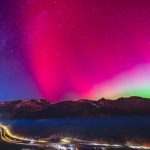From the Milky Way to shooting stars, ‘experience awe’ while stargazing in Summit County

Stephen Johnson/Courtesy photo
Every year, thousands of people visit Summit County to experience all the beauty that the Colorado Rocky Mountains have to offer, from rocky ridgelines to high-Alpine lakes, blooming wildflowers and vibrant wildlife.
Yet, one of the most dazzling sights to be encountered in Summit County is often overlooked because it is only visible at night, when weary heads are resting. The night sky — with the Milky Way, constellations and the potential for shooting stars — is a sight that inspires awe in everyone, young or old.
“You’ll never be disappointed when you get out and look up at the night sky,” Summit County resident and amateur astronomer Mark Laurin said. “You’ll always experience something that’ll make you go ‘Wow, that’s pretty cool.'”
Laurin, who runs a stargazing business offering guided tours of the night sky, is known locally by the nickname Astro Mark. As a lifelong stargazer and amateur astronomer, he’s made it his life’s mission to get people to “get out and look up at the night sky.”
- Frisco Bay Marina: Clear views over the Dillon Reservoir to the east, with lights of Frisco behind.
- West Lodgepole Street in Dillon: Great views of the western horizon from benches just off the street.
- Loveland Pass: Parking at top of pass with views in all directions.
- Hoosier Pass: South of Breckenridge, this pass has clear views.
- Green Mountain Reservoir: North of Silverthorne, this a rural part of Summit County in an open valley.
- Walter Byron Park in Frisco: An urban park with ample stargazing opportunities.
- Carter Park Sledding Hill in Breckenridge: Located near town with good views of the night sky.
- Old Dillon Reservoir Trail: A short hike with excellent views.
Lucky for Laurin, Summit County is a great place to do that. While an estimated 80% of North Americans live in cities where light pollution muddies out the milky way, Summit County is dark with far less light pollution and mountains that help to block out distant light.
Stargazing in the summertime in Summit County is a free activity that is approachable and fun for the whole family, Laurin said. It can inspire a lifetime of curiosity and exploration, he said. So, get out there and look up.
“Get out there and just experience the night sky. Just let the universe slow you down. Just take a moment to take in the universe and experience awe,” Laurin said. “It is an experience where what is happening in front of you kind of transcends your knowledge of the world and you’re confronted with something.”

How to stargaze in Summit County
Stargazing in Summit County is an activity that doesn’t require any special equipment, just a pair of eyes, darkness and clear skies.
It’s not hard to find a good stargazing spot in Summit County. On a clear night, countless stars are visible from almost anywhere in Summit County. For Laurin, one of his favorite spots is in his backyard.
Parks in and around town can be an easily accessible place for stargazing, Laurin said. But get a little further away from building lights and highways, and he said the view will be even more spectacular.
“Grab a blanket. Dress warm. Get outside in a dark spot and look up. The most important thing is to get outside and look up,” Laurin said. “Find yourself a place to relax and just start to experience the sky.”
Anna Graf, a manager at the Keystone Science School who often stargazes with students, including visitors from Denver who have never seen the Milky Way, suggests heading out just before sunset. That way, first-time stargazers can find a comfortable spot to set up while it’s still light out. Then, they can enjoy the sunset and watch the stars begin to fill the night sky.
Because it can get chilly after dark in Summit County, it is important to bring plenty of blankets and warm clothing to remain cozy, Graf said. A light source like a flashlight will also be helpful to get back home in the dark after stargazing, she said. Snacks and a warm drink, like hot cocoa, can also make the experience more enjoyable.
“Some of my favorite moments with kids and with friends who come to visit from cities involve going outside at night,” Graf said. “They’re like ‘Oh my gosh, there are so many stars.’ You just have to walk outside and look up.”

The best stargazing spots have a good view of the horizon, especially the western or eastern horizons, where many celestial events — like shooting stars — are most likely to occur, Laurin said. The mountains in Summit County can make that a little tricky, but with abundant National Forest lands, mountain passes and the Dillon Reservoir stretching through the center of the county, there are plenty of options.
One of the most important things for stargazing is to put down phones and other electronic devices — at least to start — to let your eyes adjust to the darkness, Laurin said. It takes about 20 minutes to get your “night vision,” he said, but once your eyes are adjusted, it is possible to start noticing the nuances of the night sky.
While stargazers may spot a shooting star on any given night, those who choose to stargaze during a meteor shower will be dazzled by dozens, perhaps even hundreds, of shooting stars, Laurin said.
On July 30, a double meteor shower featuring the Southern Delta Aquariids and the Alpha Capricornids will peak, and on Aug. 12 the Perseid meteor shower — one of the best of the summer — will peak. Shooting stars will also be visible in the days and weeks leading into the peak.
“There is community and communion under the night sky,” Laurin said. “I don’t know if it’s because you can’t see them, but the barriers start to drop when people are confronted by awe. They start to describe who they are as they embrace the universe around them. It’s authentic, the joy of experiencing the night sky with someone.”

What to look for while stargazing
Among the first things stargazers will notice is the hazy band of light known as the Milky Way. The Milky Way is the large, barred spiral galaxy that contains our solar system.
David Wagner, a local stargazer who has been fascinated by the night sky since his father worked on the Apollo spaceship program when he was a child, said the Milky Way never fails to inspire awe.
“The Milky Way has got to be the most amazing things you’ll ever be able to see,” Wagner said. “It stretches across the entire sky from horizon to horizon. It’s an amazing spectacle, knowing how vast it is. It’s breathtaking.”
As a stargazer’s eyes adjust, they can also start to make out the nuances of the night sky. Laurin suggests looking for “smudges,” which are usually clusters of stars born at the same period, and “dark patches” inside the Milky Way, where dark nebulae are packed so densely with cosmic dust that light can’t get through.
“A dark sky is an inky black color,” Laurin said. “Start to understand, ‘What do I see?’ Notice the size, brightness and color of the stars. Once you start to get that orientation, the next thing I would say is find the Big Dipper — all without your phone.”

The Big Dipper, one of the most recognizable asterisms in the night sky, is made up of seven of the brightest stars that take the shape of a soup spoon, near the northern hemisphere of the sky, Laurin said. An asterism is a prominent pattern or group of stars that typically take the shape of what they are named after, he said.
Once a stargazer can recognize the Big Dipper, they may want to start looking for other asterisms or even constellations, Laurin said. That’s where a smartphone can come in handy, with apps like SkyView that can help newcomers identify asterisms and constellations. Look first for asterisms like the Great Square of Pegasus and the Summer Triangle and then narrow in on constellations like Sagittarius and Scorpius.
But, don’t let the small screen of a phone distract from the grand panorama of the night sky, Laurin said. Put it down once you’ve identified a few new constellations, let your eyes readjust and reflect on the immensity of the universe that you’re gazing upon, he said. That’s really what stargazing is about.
“Be still, be quiet, and just let the universe come to you,” Laurin said. “Just appreciate what darkness does to you and how it starts to break down the barrier between you and the universe until there is no separation between you and the universe.”
This story previously published in the summer 2025 edition of Explore Summit magazine.


Support Local Journalism

Support Local Journalism
As a Summit Daily News reader, you make our work possible.
Summit Daily is embarking on a multiyear project to digitize its archives going back to 1989 and make them available to the public in partnership with the Colorado Historic Newspapers Collection. The full project is expected to cost about $165,000. All donations made in 2023 will go directly toward this project.
Every contribution, no matter the size, will make a difference.










